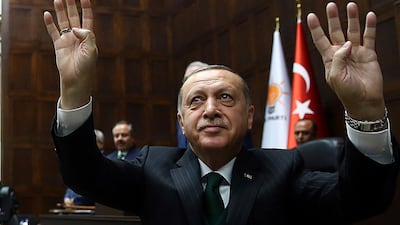Turkey’s credit rating was cut further into junk by Moody’s Investors Service on an erosion of institutional strength as well as more risk of external shocks and geopolitical risks. The lira weakened.
Moody’s lowered the rating one notch to Ba2, two levels below investment grade, with a stable outlook, Moody’s analyst Kristin Lindow said in a statement Wednesday. That leaves the nation on par with Brazil, Croatia and Costa Rica.
The government of President Recep Tayyip Erdogan appears focused on short-term measures, undermining effective monetary policy and economic reform, Ms Lindow wrote. Persistent inflation and political drivers, such as the ongoing state of emergency following an attempted coup in 2016, have weighed on the country. Debt and rollover needs have worsened, she wrote.
______________
Read more:
Post-coup crackdown sees Turkish universities slide in global ratings
Turkish helicopter shot down by Kurdish militia in Syria's Afrin
______________
“The potential triggers of a re-evaluation of Turkish country risk by foreign investors continue to multiply with the continuing deterioration of Turkey’s geopolitical situation,” Ms Lindow wrote. “Turkey’s sovereign rating would likely be downgraded if there is a material increase in the probability and proximity of a balance of payments crisis.”
Moody’s cited the refusal to implement a decision in January by the Constitutional Court to release journalists Mehmet Altan and Sahin Alpay, who were charged with attempting to destroy the constitutional order. Mr Altan was later sentenced to life, while Mr Alpay awaits his verdict.
“The geopolitical risk arising from Turkey’s recent engagement in Syria becomes more marked the longer and deeper the engagement goes on,” Moody’s said, regarding the “Olive Branch” offensive against Syrian Kurdish militants that started Jan. 20.
The lira fell as much as 0.4 per cent to 3.8093 per US dollar after the downgrade, and was trading 0.2 per cent lower at 3.8072 at 10:25 a.m. local time. The currency is little changed so far this year, compared with a 2.5 per cent gain in the MSCI index of emerging-market currencies. Ten-year government bond yields rose as much as 10 basis points to 12.3 percent.
Moody’s also downgraded the long-term senior unsecured debt of state-run Hazine Mustesarligi Varlik Kiralama, a Turkish special purpose vehicle used to issue sukuk lease certificates.

